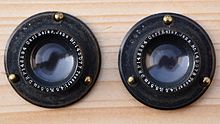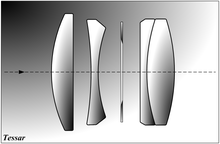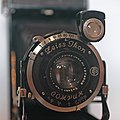Tessar
The Tessar is one of the most popular types of photographic lenses and is a brand name . It was calculated by Paul Rudolph and patented on April 25, 1902 for the Carl Zeiss company . More than 100 million lenses of this type (original and imitation) have been built since then.
construction
The Tessar is a further developed variant of the Anastigmat type, resulting from the combination of the two predecessors Protar and Unar, also calculated by Paul Rudolph . The Tessar is characterized by an optical image quality that was unmatched for its time of creation; With only slight spherical zone errors, the best center sharpness and good color correction, it is practically free of astigmatism and field curvature , whereby the actual optical performance depends on the production time and calculation. The low distortion of the image still suffices for reproduction requirements.
The Tessar - an acronym from the Greek word tessares (τέσσαρες = four) - is a four-part, asymmetrically constructed lens, the four lenses of which are divided into two groups by the aperture . The two lenses in the front group are mounted at an air gap to one another and thus form a pair of neighboring surfaces with an overall scattering or negative refractive power, whereas the two lenses in the rear group are cemented to form a collecting double element . This results in a considerable increase in performance compared to the simple triplet . It has a simpler structure than the Heliar from Voigtländer, which was introduced in 1900 and is derived from the Cooke triplet . With the Heliar, the front and rear elements each consist of two cemented lenses.

The Tessar initially only had a light intensity of 1: 6.3. Recalculations improved the focal ratio to 1: 4.5 or 1: 3.5 ( Ernst Wandersleb , 1907) and made it known all over the world as the “eagle eye of the camera”. The Tessars manufactured from 1924 with a speed of 1: 2.7 and focal lengths from 1.5 to 16.5 cm did not quite meet expectations, the number of units remained low. A recalculation was the small picture -Tessary 2.8 / 5 cm by Willy Merté from 1931. Also through recalculations, the light intensity 2.8 was also achieved for the medium-format Tessary in 1932 (focal length 7.5 cm e.g. for Exakta 4 × 6.5) or 1933 (8 cm e.g. for Super-Ikonta 6 × 6).
The first protected company logo from Carl Zeiss Jena was derived from the lens scheme of the rear section of the Tessar. This testifies to the great importance of this lens for the Zeiss company.
Manufacturer
All of the major lens manufacturers brought Tessar-type lenses onto the market after the property rights had expired in 1922:
- Elmar ( Leitz )
- Primotar (also as " Ihagee Anast. Exaktar") ( Meyer-Optik )
- Minotar , Minoxar , Minar ( Minox 35 )
- Complan ( Minox , miniature camera )
- Skopar ( Voigtlander )
- Solinar or Solitar ( Agfa )
- Xenar ( Schneider Kreuznach )
- Ektar ( Kodak )
- Macro Takumar ( Pentax )
gallery
Tessar on a Zeiss Ikon Ikonta with Compur lock
Pentacon Exa 1a with Tessar 2.8 / 50
Tessar 2.8 / 50 for small picture - SLR , Carl Zeiss, Jena, about 1976
Rollei 35 with Tessar 3.5 / 40 lens
Minotar lens of a Minox 35 GL. The two elements of the cover can be seen, directly behind the central lock
Uncoated Elmar f = 5cm 1: 3.5 -Tessar type for the screw Leica , approx. 1935 (modern use on a digital camera )
" Luftbildkarte " ( picture postcard ) of the Rudelsburg from 1910, with explicit mention of the "Zeiss-Tessar" lens
Compact camera T4 from Yashica with Tessar 3.5 / 35
Web links
Individual evidence
- ↑ Trademark register
- ↑ HH Nasse: Das Tessar - from the article series "Lens Names" by Carl Zeiss AG, Camera Lens Division; March 2011
- ↑ Wolfgang Baier: Source representations for the history of photography . 2nd edition, Schirmer / Mosel, Munich 1980, ISBN 3-921375-60-6 , p. 311










